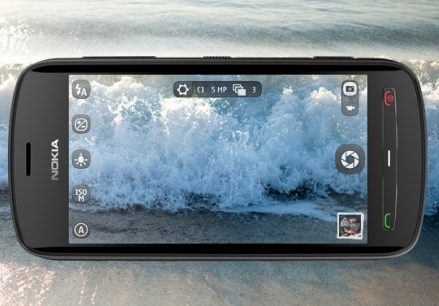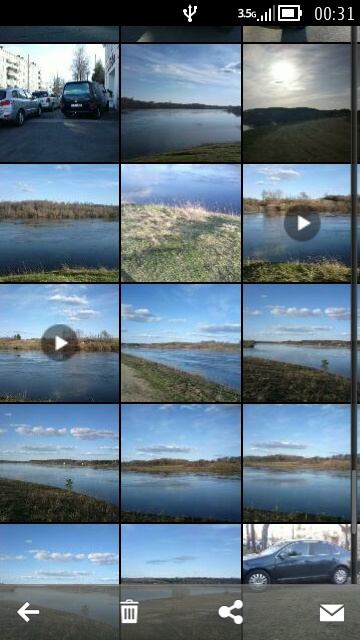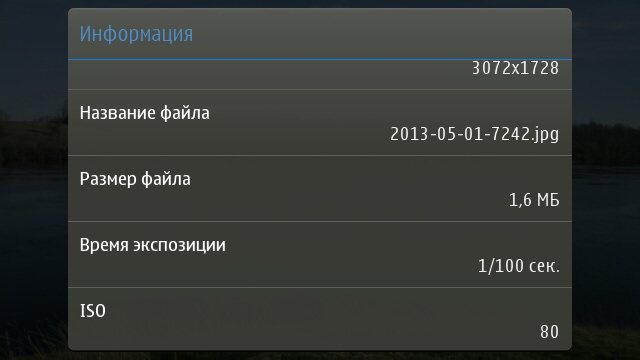Is Symbian Dead or A Tale of Cameraphones Dead?

Good day, Habr. Several factors prompted me to write this note - the experience of communicating with other people from the Nokia fan community, notes and analyzes on Habré, as well as my own experience in choosing suitable smartphones.
As usual, there are a lot of people in “these your Internet”, each has his own opinion, his own arguments and counterarguments, but people like to simply succumb to fashion and scold something simply because it is a trend. My post is designed to dispel the prevailing opinion of Symbian, its capabilities and current status. I will build the main part of the arguments on the example of camera phones, I will tell and explain how and why I got carried away with them, so if you are interested, welcome and get ready to spend traffic on photo and video examples.
How it all began
Perhaps it’s worth mentioning right away that I am a fairly old fan of Nokia devices - it all started with the famous 3310, then followed by the 3510i, followed by the 6230i, the purchase of the N95 was a big step forward for me, further research on forums and shops led me to buying at least the famous N8. In terms of changing phones, I am inclined to consider myself a rather lucky person, since all the changes, except for one, occurred as part of the upgrade of the existing phone to something new, which has much greater capabilities.
Nokia 6230i
If with models 3310 and 3510i everything is basically obvious, then with all the rest things were already a little more complicated. So, starting with 6230i, the camera became one of the important characteristics of the device for me - in the summer of 2006, when I was still a schoolboy, I was simply struck by 1.3 Mpx with an incredible resolution at that time - 1280x1024. At that time, 640x480 phones were the usual camera resolution, you couldn’t even dream about autofocus, but the only alternative to such a device could be a bunch of a simple phone + a cheap soap box + a cheap MP3 player, which turned out to be no cheaper than one device in the form Nokia 6230i Be that as it may, after going to the store, having obtained this unit, I immediately began to master all its capabilities. There was browsing via mobile Internet, and listening to music, and reading books (yes, at 1.5 " screen with a resolution of 208x208 pixels), and of course, shooting photos and videos in all possible situations. Many of you will probably say, “Yes, what kind of photos could be taken with the help of that ridiculous camera, nonsense,” and perhaps they will be right. To obtain a more or less normal photo, almost ideal conditions were really required - good illumination, proper position relative to the light source, strong arm (especially for night photos). However, something decent could be removed with the Nokia 6230i: correct position relative to the light source, strong hand (especially for night photos). However, something decent could be removed with the Nokia 6230i: correct position relative to the light source, strong hand (especially for night photos). However, something decent could be removed with the Nokia 6230i:



In my opinion, it’s quite enough to capture some life situations, some photos after being processed by a Photoshop
Nokia N95
So, by the summer of 2008, I finally “matured” to replace the existing device and first of all I paid attention to Nokia devices, namely, the N95 model. The impressions from the first meeting were extremely positive - almost a double screen diagonal (compared to the 6230i), multitasking, maps with GPS, WiFi, TV and audio outputs via a 3.5mm mini-jack, and of course, a camera. The N95 camera at that time was really out of competition: 5 Mpx photo resolution, autofocus, LED flash, video recording with a resolution of 640x480 and a frame rate of 30fps. Simply put, the N95 was really rich in functionality and, when used correctly, turned into a mini-computer. It was then that I developed a list of requirements for the functional capabilities that any normal smartphone should have:
- Viewing pages on the Internet without losing functionality, compared to the same pages on a PC (scrolling, JS, zooming in and out, downloading and uploading files through a browser when working with any site)
- Switch between several open applications, their work in the background
- Easy file transfer via Bluetooth or USB, without third-party software and artificial restrictions
- View and edit various documents (.doc, .pdf, .djvu, etc.)
- Flexible management of camera settings (photo modes, file names, save location, the ability to pause video recording and then continue, zoom when shooting video)
As history has shown, not all of these elementary things were in iOS, Android, Windows Phone 8 ...
As for photos and video shooting, with n95 this hobby came to a whole new level and I came to the conclusion that I did not want to carry it around with me all the time. “Soap box” or “DSLR” with a camcorder. The quality of the photos has risen to a very decent level, do not forget, this is 2008-2010:





Nokia N8
As for the Nokia N8, at first its purchase was seen by me as a simple evolutionary transition from one good smartphone to another. Yes, the N8 has a larger and better screen than the N95 (3.5 "AMOLED vs 2.6" TFT, 640x360 vs 320x240, GorillaGlass against a simple display glass), the clock speed and RAM are also doubled, the aluminum case against plastic, the xenon flash against LED, 12Mpx cameras versus 5Mpx, and everything else, the new version of the operating system is Symbian ^ 3. In fact, there were not so many innovations and visual changes, and they did not enter into a stupor. Using the S60 as an example, I was quite familiar with Symbian, I had a good idea of its capabilities, strengths and weaknesses. Based on this, I just focused on studying the hardware stuffing, was happy about the increased speed of the system, free GPS navigation, improved image and video quality. It is worth noting that the “boxed" version of Symbian ^ 3 was not ideal and Nokia was constantly working on improvements, corrections, and expanding the functionality of the device. The first major update was Symbian Anna, which improved system stability, added beauty to the UI, and brought with it a set of new minor flaws. As often happens, the system became a real workhorse only after the second major update - Symbian Belle. adding beauty to the UI and bringing with it a set of new minor flaws. As often happens, the system became a real workhorse only after the second major update - Symbian Belle. adding beauty to the UI and bringing with it a set of new minor flaws. As often happens, the system became a real workhorse only after the second major update - Symbian Belle.
At that time, the prospect of curtailing work on Symbian clearly loomed on the horizon, and it was in Belle that Nokia developers tried to finally correct many of the annoying omissions of previous years. So, the number of desktops was increased, a “curtain” appeared in the upper part of the screen, pulling it to expand the quick access panel, changed the type of SMS messages chat, increased the frame rate during video recording to 30fps, and added elements to the camera’s interface more precise settings. Moreover, after installing Belle, the smartphone began to behave more stably, did not freeze and could work without turning off or rebooting for several weeks.
As time passed, the Nokia N8 faithfully served me as a mobile computer, player, camera, camcorder. Several thousand photographs were taken, hundreds of videos were shot, even all the moments of the vacation were shot and mounted in 720p. Of course, over time, the flaws of the device became noticeable, more precisely, the N8 became obsolete. The abundance of jquery, all kinds of plug-in libraries, even outdated Flash-videos on the pages of sites has led to the fact that most of them are not quite comfortable to view due to slow loading and banal "brakes". Installing an SSD in my home computer even developed a dislike for me of any kind of delays and expectations when working with various devices, and the resolution of 1280x720 when shooting video in 2012 was already not enough to document the events happening around me.
Perhaps, only the quality of the photos suited me:








A tough choice between Nokia Lumia 920 and Nokia 808 Pureview
In the summer of 2012, I began to think about replacing the N8 with something more advanced. In fact, there were only 2 candidates - either the 808 Pureview or the Lumia 920. The iPhone wasn’t considered fundamentally due to the modest photo and video capabilities and inflated price (fans of Apple products will forgive me), Samsung, HTC and Sony products couldn’t to please when evaluating the apparatus as a whole. 5 "I didn’t want to take a“ shovel ", it wasn’t the best solution to charge a smartphone every night, physical disabilities like the lack of a xenon flash supplemented artificial problems like slowing down the interface, the inability to simply and quickly upload files via USB, etc.
If we talk about the previously mentioned Nokia devices (808 Pureview and Lumia 920), then, in principle, everything was clear. The first is a further development of the concept of N8 and by and large doubles its characteristics, the second is the representative of the new line of smartphones and in many ways its capabilities depend not so much on Nokia itself as on the new Microsoft operating system. Appeared reviewallowed to form the first impression, which was then adjusted in the course of reading a large topic with a discussion of this unit. It should be noted that the first impression was very pleasant, the filling of the Lumia 920 was quite decent, and the new tiled interface seemed logical and convenient. As before, I decided not to spoil the fever and wait for the moment when in our country it will be possible to buy this model in fairly large stores. I did not want to contact dubious shops, and as time has shown, over the course of several months, the price of the device fell by 150 euros. As it turned out, the decision to wait was correct, because the forums started to “pop up” problems and inconveniences that were invisible at first glance - the inability to create a playlist of tracks in the smartphone itself, the strange behavior of the smartphone when answering a call,
- Inability to upload a file to the site through the browser (the OS does not allow the browser to select a file from memory)
- Inability to pause video recording and then continue shooting
- Lack of zoom when shooting video (you can “zoom in” the object and start recording, then stop recording, remove zoom and start recording in a new file)
The last two points look especially strange, because the Lumia 920 boasts PureView technology, which means this camera phone is to some extent. Several particularly loyal fans on one of the forums tried to convince me that uploading photos through a browser was not necessary, because there are separate applications for these purposes. The only trouble is that the application allows, for example, upload photos to Facebook, but it is not able to upload documents to millions of other sites. That is, having bought a top-end smartphone on Windows Phone 8, you can’t just go to your favorite site and share a photo, a screenshot, a document, an audio file with other people in the end. Instead, it is suggested to upload this file to SkyDrive and share the link. But SkyDrive, as they say, is not rubber, and this method is not always suitable, Often you need to "just pick up and download." Paradoxically, but forgotten and buried by all, Symbian allows you to upload any files to any sites through the browser, you can create and edit playlists in its player, and the standard camera application allows you to use the zoom when shooting video and pause recording as much as you like .
Nokia 808 Pureview
So, after weighing all the pros and cons, I realized that at the moment, the transition from Symbian ^ 3 to Windows Phone 8 will be a step back for me, and along with a beautiful tiled interface I will get completely ridiculous, artificially created barriers and restrictions. Once again, seeding for reading reviews and analyzing the prices of smartphones in our stores, I again returned to the thought of buying the 808 Pureview, which was finally done. Oddly enough, Symbian Belle versions vary from device to device. Today, for Nokia N8, the latest official version of the software is Belle Refresh, and for 808 Pureview (as for a more productive device) it is Belle Feature Pack 2. At first glance, the differences between them are not so significant, however, Belle FP2 uses more accurate fonts, pop-up windows have a rounded shape, The camera control interface has been improved and expanded, and the audio bitrate for recorded videos has been doubled (up to 256 kbps). In general, the entire operation of the OS looks more stable, and the scrolling of the interface elements is smoother. I foresee possible negative reviews about the overall design of Symbian ^ 3, but since all this is very subjective, I still give examples:

Main desktop

Desktop with mail widgets, events, connection management

Opened curtain of the quick access panel

Gallery

View photos Photo

information

Open applications with quick access to them
Glamor in Symbian ^ 3 you probably won’t find, but perform its functions and provide the user access to the necessary applications or data, this OS may well.
As for the photos and videos, a separate big review would be needed here, with an explanation of how exactly the Pureview technology works in this case, what it gives and why you need a sensor as much as 41 Mpx. Instead, I just give an example of a few photos and a small mounted movie.
There are not so many photographs taken at the moment, so as an example there are only 4 (+1): In my personal opinion, it makes sense to take full-size photos at 38 or at 33.4Mpx only when taking landscapes and panoramas, moreover, it is extremely desirable for this have a tripod, otherwise the photos may be slightly blurry. For all other occasions, photos with a resolution of 5Mpx using PureView technology are quite enough. It is also worth noting that with a tripod, you can take photos with shutter speeds up to 2.7 seconds. This shutter speed allows you to get quite decent (for a smartphone or “soap box”) photographs in low light conditions in cases where it is impossible to use a xenon flash, or simply not practical. As an example:





This photo was taken at night, in the light of streetlights, without using a flash.
If we talk about the video capabilities of the Nokia 808 Pureview, it’s worthwhile to conditionally divide this conversation into two parts - the quality of the recorded video and sound quality. Due to the enormous resolution of the 808 sensor, Pureview allows you to use digital zoom without loss in quality. You can verify this with the help of such a simple test:
Original
When using a tripod, the quality of shooting improves and in some cases it is not always possible to immediately determine whether 3 zoom is currently being used or not.
To record sound when shooting videos, Rich Recording Technology is used, which has already been discussed on Habré.
As a confirmation of its capabilities, I suggest watching this video:
On Youtube views, you can find many other examples ( one , two ).
Despite the fact that the N8 was significantly ahead of its competitors in sound recording quality, even he could not record sound from the fan zone without distortion:
The 808 Pureview that succeeded him literally significantly raised the bar for sound recording quality, especially in loud and noisy vacation spots of its owner.
In general, the photo and video capabilities of this unit allow you not to carry either a cheap digital camera or a camcorder, and take a digital SLR camera only in exceptional cases when there is both an opportunity and a need. If we talk about Symbian Belle FP2 itself, then at the moment it is a quite adequate alternative to Windows Phone 8 and Android, if you need a simple and reliable tool, and not an expensive and moody toy.
conclusions
As a result of the whole long story, thoughts, analysis, and everything else, I would like to say the following: if you are confused with the choice of a smartphone only Symbian Belle on board, try to look at the situation objectively and think sensibly. At the moment, Symbian is a completely adult operating system that has survived its childhood illnesses, it has not been abandoned, it has not been forgotten, there is both official support and various mods and programs from third-party developers. Symbian’s reputation is largely based on rumors and unverified facts, but in reality it turns out that everything is not so gloomy, and in some cases a person holding a Symbian Belle device has much more possibilities than his friend, with an Android device , IOS or WinPhone8.
Thank you for your attention, I hope you were interested in looking at the situation behind the Iron Curtain.
